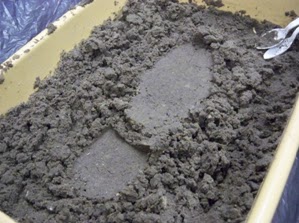A foot print in a crime scene can be extremely useful to detectives on that crime scene. Prints can tell which way a suspect may have come from of the direction they left. The print tells what shoe size and what type of shoe they were wearing. If the print is good enough and the sole of the shoe isn’t very worn even brand names and designs can be seen, making easier to catch a suspect. Sometimes gender can even be decided based on the size and shoe type of the impression. It is important to analyze footprints quickly since weather condition or other impressions could disturb the print. If a forensics expert does not have time to analyze the print right away they will make a mold of it and analyze it later.
In class we split into groups of about three or four and filled a large rectangle container with dirt/sand. Make sure the dirt is not too moist or else the print will not stay intact for analysis.
Then each person takes turns making their shoe impression in the dirt must fill out a sheet for each group member’s footprint. This sheet includes the weather conditions, substrate, number of tracks, length and width of print, characteristics of the print, and an overall conclusion for your analysis of the print.
Repeat this process until you have analyzed the footprint of each person in your group.
Questions:
1. What was you analysis of each print?
 The first print we analyzed was a boot with a small slanted heel and we concluded that the person probably wore about a size eight shoe size and may have worn the shoes often since the bottom was so worn that no markings or treads could be distinguished. They were also most likely female because of the size and shape of the shoe.
The first print we analyzed was a boot with a small slanted heel and we concluded that the person probably wore about a size eight shoe size and may have worn the shoes often since the bottom was so worn that no markings or treads could be distinguished. They were also most likely female because of the size and shape of the shoe.The second shoe was a boot with a short chunk heel. We decided that the person wears about a size nine in women’s shoes and nothing can be distinguished from the soles since they were so worn.
The last print was from a flat shoe which was about a size eightin women’s and was not very worn since we could see distinct impressions of a flowery vine pattern between the ball and heel of the print.
2. What are some similarities and differences of each shoe type observed?
We observed three types of shoes, a flat shoe, a boot w/ a small slanted heel, and a boot with a short chunk heel. The flat shoe did not have much of an arch and there was no line or break between the ball and heel of the shoe. The impression also showed that pressure was distributed fairly equally throughout the print.
The boot with the slanted heel was similar to the flat but had a slightly higher arch and the shape was less definite than the flat. There was also a bit more pressure on the heel than the ball of the foot.
 The boot with the chunk heel was very different than the other two shoe types. The ball of the foot was somewhat wider than the other two but the most distinct feature was the separation of the heel from the front portion of the shoe. Since the arch is so elevated the heel seems to be unconnected to the ball. Also the heel was farther into the dirt which shows that there was much more pressure on that portion of the shoe.
The boot with the chunk heel was very different than the other two shoe types. The ball of the foot was somewhat wider than the other two but the most distinct feature was the separation of the heel from the front portion of the shoe. Since the arch is so elevated the heel seems to be unconnected to the ball. Also the heel was farther into the dirt which shows that there was much more pressure on that portion of the shoe.3. What are some similarities and differences of male and female shoes?
Although similar in shape the male and female foot mostly differs in size. The male shoe is usually larger than a female shoe since the feet of males are generally bigger than female’s. We noticed that the dimensions of a boy’s footprint were larger in dimensions than the dimension we collected of girl’s footprints.






From the pictures, it looks like your footprints were very defined in the mud. This probably made your results very accurate, but I wonder in a real scenario if it would that simple.
ReplyDeleteGood job! You're lucky your group was wearing all different shoes, my group was all wearing Converse that day so we didn't really get a lot of information from our lab.
ReplyDeleteI really like your pictures! I think we have a photographer in our cohort!!! (haha) I also thought your writing was very informative.
ReplyDelete